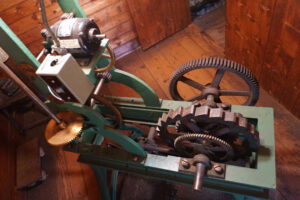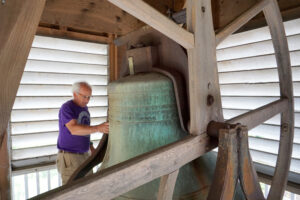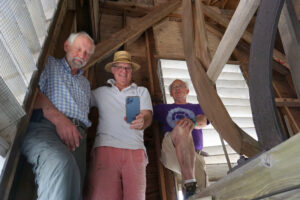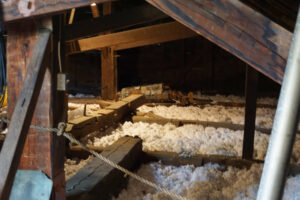Jul 30, 2023
Medfield’s outgoing keeper of the clock, David Maxson, has given many Medfield Day steeple tours at the NRHP-listed First Parish Unitarian Universalist church. Before moving to Connecticut, he gave what may be a farewell tour for Mike Taylor, Don Rolph, and other members of the church’s buildings and grounds committee.
Until the early 19th century, the building served not only as a church, but also as the Medfield town meetinghouse. It is the oldest building in Medfield that is open to the public. The present structure, which dates from 1789, was preceded by two smaller buildings on the site, put up in 1651 and 1701. It was added to the National Register of Historic Places in 1974.
About the Clock

From Tilden’s History of Medfield, 1801: Voted that the old bell be sent to Boston and recast as near on the same form and size as might be. Also voted to take charge of the clock that had been bought for the meetinghouse, and have it wound at the expense of the town. There is no record of the purchase of the town clock, and it was probably a gift of individuals.
That clock remained in service until 1862, when the present clock was installed. The “new” clock originally was regulated by a pendulum and driven by weights, which the keeper of the clock had to raise each week, before the clock was electrified in 1968. (The weights are still lying on the floor up there. Not far away is the tip of the steeple that was blown off and pierced the church roof in the hurricane of 1938.)
Old clocks can last for centuries. The Morse clock in the historical society is nearly 250 years old, and it still works and keeps fairly good time. It is driven by weights, which must be raised every several days, and it is regulated by a pendulum. If the clock runs fast or slow, there’s an adjustment knob to use to raise or lower the pendulum weight, but it’s a catch-as-catch-can process.
The pendulum clock was invented in 1656 by Christiaan Huygens, and it resulted in a quantum leap in clock accuracy over the mainspring, which preceded it by a century. The clock at the Salisbury Cathedral in England still has most of its original parts from 1386 and is considered one of the oldest working clocks in the world.
About the Bell

The Holbrook bell high up in the tower of the old meetinghouse, First Parish Unitarian Universalist Church, is several feet across and weighs upwards of a ton, and its dominant tone is F-sharp above Middle C. (Holbrook bells were acclaimed world-wide for their superior musical tone.)
For a century the bell was attached to the town clock and pealed each hour. But when the clock was electrified in 1968 to reduce maintenance and improve its accuracy, there wasn’t enough money in the budget to adapt the old striking mechanism to the more modern drive.
Thus, this splendid bell is now silent except for special occasions and for calling people to church on Sunday morning.
The bell was cast and installed in 1868 by Holbrook & Sons Foundry, at the corner of Main and Spring Streets, East Medway (now Millis). It is one of over 11,000 bells turned out by this company over its long history.
Harvard (seven), Yale, Bowdoin, Dartmouth, Brown, and Trinity all have Holbrook bells in their clock towers. A significant number were shipped around Cape Horn at the bottom of South America and sold in California and Hawaii.

George Holbrook (1767-1846), after an apprenticeship with Paul Revere, opened a foundry and blast furnace in Brookfield, Mass., in 1797. He stayed there until 1812, when he was rendered destitute: he had cosigned a loan for a “friend,” and when the other man defaulted, creditors seized Holbrook’s business, home, and all his assets.
Holbrook received a chilly reception when he returned to his native Wrentham; the townspeople did not want another pauper on their alms rolls.
But Holbrook luckily won the contract to supply a bell for the new meetinghouse in East Medway. He improvised his blast furnace and casting equipment near the construction site, and, with a showman’s flair, attracted a large audience who watched the casting of the 1,200-pound bell. The $535 he received from this successful project enabled him to restart his business, in which he was joined by his son, George Handel Holbrook (1798-1875).
The son also became a prominent local musician who numbered among his friends Lowell Mason and Jonas Chickering, the famed piano manufacturer. George Handel Holbrook is credited with refining the bells to produce superior musical tones.

The company prospered, and other family members established the Holbrook Organ Company and the Holbrook Tower Clock Works. After George Handel Holbrook died in 1875, the bell company went into decline. His grandson, Edwin Handel Holbrook, sold the plans and patterns for the bells to a company in San Francisco in 1882. He took a government job in Washington, D.C. and died in 1915.